SNPG959: Workplace Culture's Impact on Patient Outcomes and Staff
VerifiedAdded on 2022/10/11
|12
|3268
|8
Essay
AI Summary
This essay examines the impact of workplace culture on healthcare settings, emphasizing patient outcomes, staff satisfaction, and the delivery of person-centered care. It explores the consequences of ineffective workplace cultures, such as compromised patient care, staff attrition, and economic resource strain. The essay delves into the attributes of effective workplace culture, including person-centeredness, teamwork, and open communication, while also addressing challenges like lack of transparency and leadership issues. It highlights the importance of transformational leadership, shared governance, and the use of change management models like Kotter's approach to foster positive changes. The discussion covers strategies to improve workplace culture, such as fostering collaboration, providing adequate support, and encouraging employee participation in decision-making. The essay concludes by emphasizing that an effective workplace culture is evidence-based and adaptable, leading to empowered employees, improved job and patient satisfaction, and efficient workflows. The essay also analyzes the impact of workplace culture on patient outcomes, staff satisfaction, and person-centered care.

Running head: NURSING (SNPG959)
Name of the student:
Name of the university:
Author note
Name of the student:
Name of the university:
Author note
Paraphrase This Document
Need a fresh take? Get an instant paraphrase of this document with our AI Paraphraser
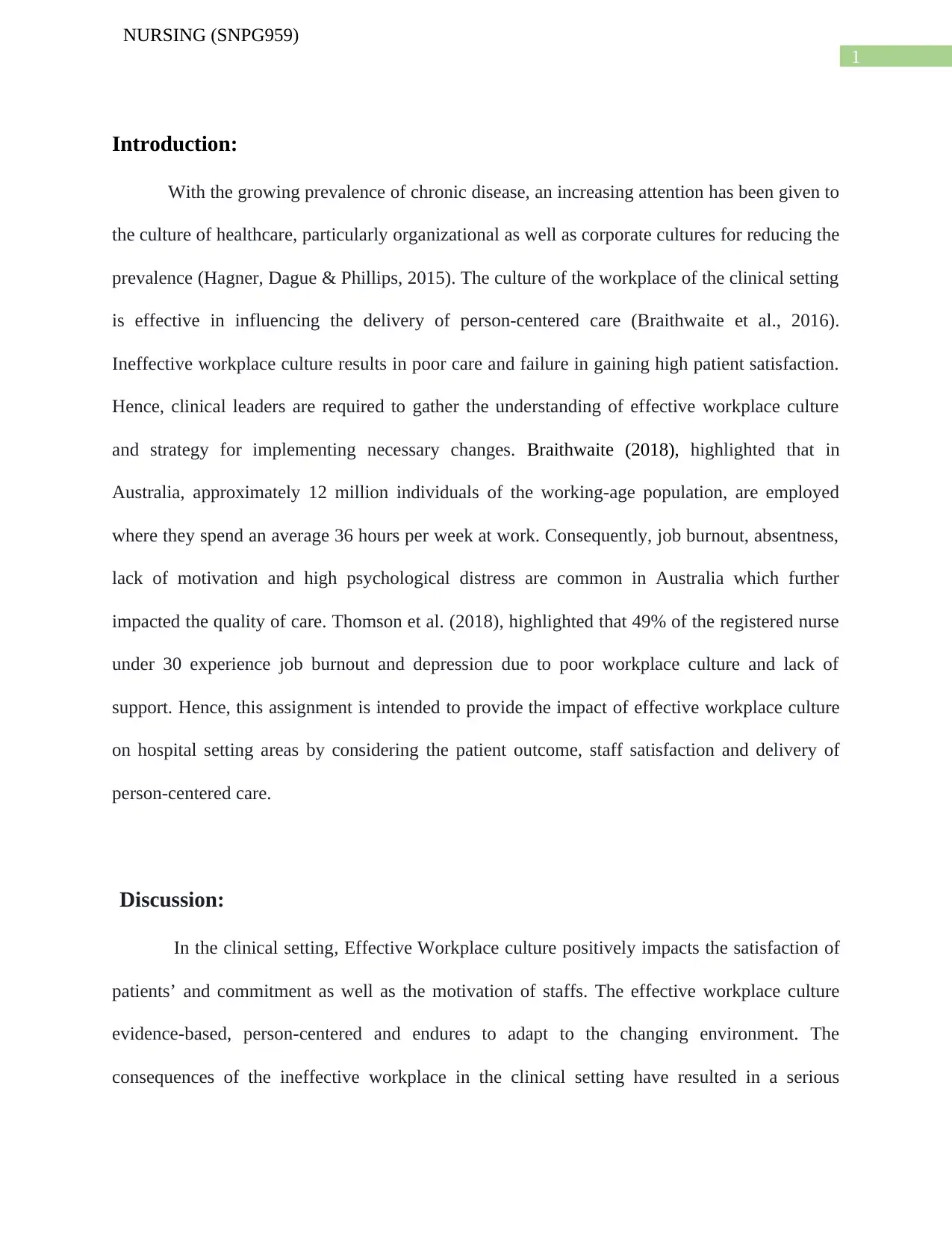
1
NURSING (SNPG959)
Introduction:
With the growing prevalence of chronic disease, an increasing attention has been given to
the culture of healthcare, particularly organizational as well as corporate cultures for reducing the
prevalence (Hagner, Dague & Phillips, 2015). The culture of the workplace of the clinical setting
is effective in influencing the delivery of person-centered care (Braithwaite et al., 2016).
Ineffective workplace culture results in poor care and failure in gaining high patient satisfaction.
Hence, clinical leaders are required to gather the understanding of effective workplace culture
and strategy for implementing necessary changes. Braithwaite (2018), highlighted that in
Australia, approximately 12 million individuals of the working-age population, are employed
where they spend an average 36 hours per week at work. Consequently, job burnout, absentness,
lack of motivation and high psychological distress are common in Australia which further
impacted the quality of care. Thomson et al. (2018), highlighted that 49% of the registered nurse
under 30 experience job burnout and depression due to poor workplace culture and lack of
support. Hence, this assignment is intended to provide the impact of effective workplace culture
on hospital setting areas by considering the patient outcome, staff satisfaction and delivery of
person-centered care.
Discussion:
In the clinical setting, Effective Workplace culture positively impacts the satisfaction of
patients’ and commitment as well as the motivation of staffs. The effective workplace culture
evidence-based, person-centered and endures to adapt to the changing environment. The
consequences of the ineffective workplace in the clinical setting have resulted in a serious
NURSING (SNPG959)
Introduction:
With the growing prevalence of chronic disease, an increasing attention has been given to
the culture of healthcare, particularly organizational as well as corporate cultures for reducing the
prevalence (Hagner, Dague & Phillips, 2015). The culture of the workplace of the clinical setting
is effective in influencing the delivery of person-centered care (Braithwaite et al., 2016).
Ineffective workplace culture results in poor care and failure in gaining high patient satisfaction.
Hence, clinical leaders are required to gather the understanding of effective workplace culture
and strategy for implementing necessary changes. Braithwaite (2018), highlighted that in
Australia, approximately 12 million individuals of the working-age population, are employed
where they spend an average 36 hours per week at work. Consequently, job burnout, absentness,
lack of motivation and high psychological distress are common in Australia which further
impacted the quality of care. Thomson et al. (2018), highlighted that 49% of the registered nurse
under 30 experience job burnout and depression due to poor workplace culture and lack of
support. Hence, this assignment is intended to provide the impact of effective workplace culture
on hospital setting areas by considering the patient outcome, staff satisfaction and delivery of
person-centered care.
Discussion:
In the clinical setting, Effective Workplace culture positively impacts the satisfaction of
patients’ and commitment as well as the motivation of staffs. The effective workplace culture
evidence-based, person-centered and endures to adapt to the changing environment. The
consequences of the ineffective workplace in the clinical setting have resulted in a serious
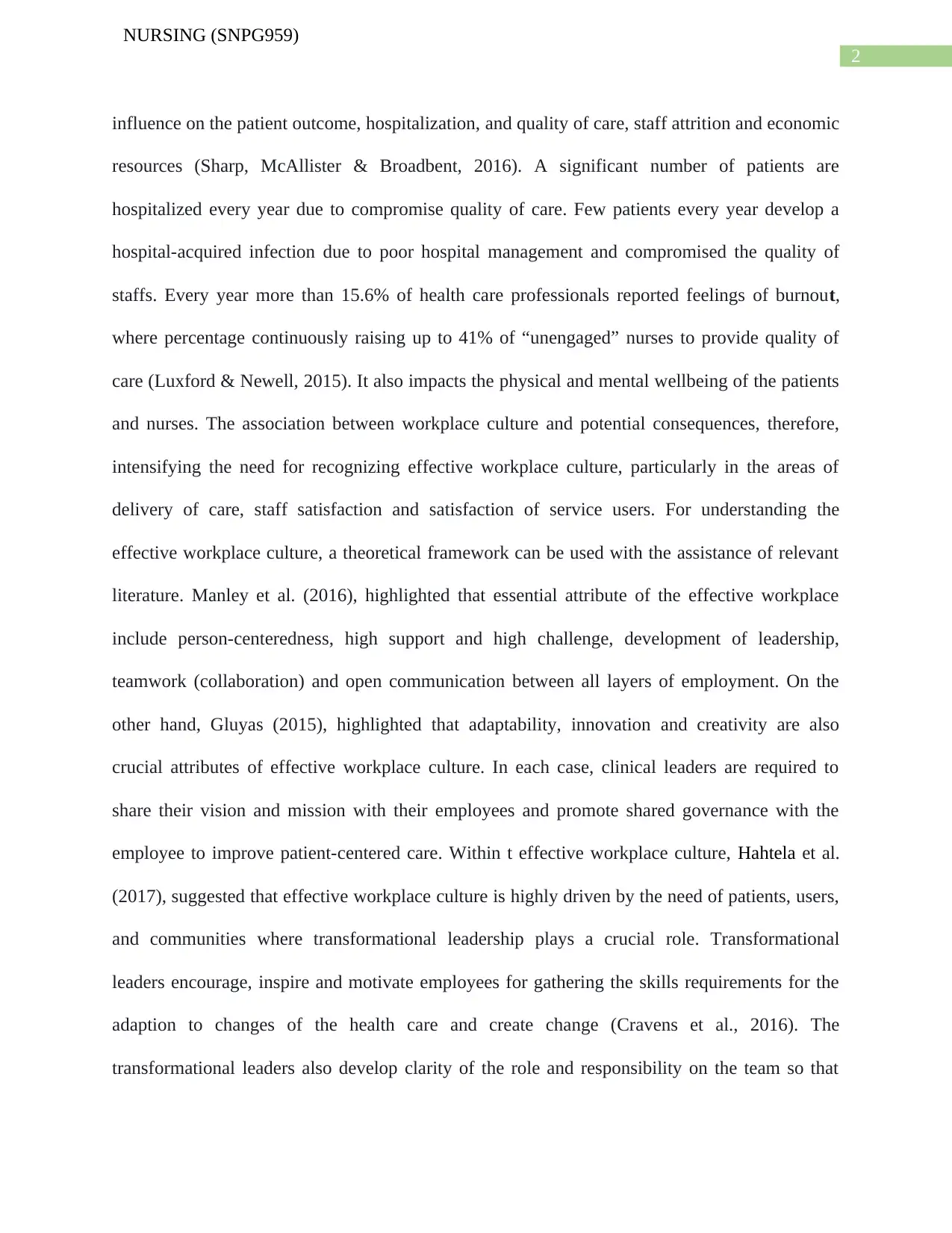
2
NURSING (SNPG959)
influence on the patient outcome, hospitalization, and quality of care, staff attrition and economic
resources (Sharp, McAllister & Broadbent, 2016). A significant number of patients are
hospitalized every year due to compromise quality of care. Few patients every year develop a
hospital-acquired infection due to poor hospital management and compromised the quality of
staffs. Every year more than 15.6% of health care professionals reported feelings of burnout,
where percentage continuously raising up to 41% of “unengaged” nurses to provide quality of
care (Luxford & Newell, 2015). It also impacts the physical and mental wellbeing of the patients
and nurses. The association between workplace culture and potential consequences, therefore,
intensifying the need for recognizing effective workplace culture, particularly in the areas of
delivery of care, staff satisfaction and satisfaction of service users. For understanding the
effective workplace culture, a theoretical framework can be used with the assistance of relevant
literature. Manley et al. (2016), highlighted that essential attribute of the effective workplace
include person-centeredness, high support and high challenge, development of leadership,
teamwork (collaboration) and open communication between all layers of employment. On the
other hand, Gluyas (2015), highlighted that adaptability, innovation and creativity are also
crucial attributes of effective workplace culture. In each case, clinical leaders are required to
share their vision and mission with their employees and promote shared governance with the
employee to improve patient-centered care. Within t effective workplace culture, Hahtela et al.
(2017), suggested that effective workplace culture is highly driven by the need of patients, users,
and communities where transformational leadership plays a crucial role. Transformational
leaders encourage, inspire and motivate employees for gathering the skills requirements for the
adaption to changes of the health care and create change (Cravens et al., 2016). The
transformational leaders also develop clarity of the role and responsibility on the team so that
NURSING (SNPG959)
influence on the patient outcome, hospitalization, and quality of care, staff attrition and economic
resources (Sharp, McAllister & Broadbent, 2016). A significant number of patients are
hospitalized every year due to compromise quality of care. Few patients every year develop a
hospital-acquired infection due to poor hospital management and compromised the quality of
staffs. Every year more than 15.6% of health care professionals reported feelings of burnout,
where percentage continuously raising up to 41% of “unengaged” nurses to provide quality of
care (Luxford & Newell, 2015). It also impacts the physical and mental wellbeing of the patients
and nurses. The association between workplace culture and potential consequences, therefore,
intensifying the need for recognizing effective workplace culture, particularly in the areas of
delivery of care, staff satisfaction and satisfaction of service users. For understanding the
effective workplace culture, a theoretical framework can be used with the assistance of relevant
literature. Manley et al. (2016), highlighted that essential attribute of the effective workplace
include person-centeredness, high support and high challenge, development of leadership,
teamwork (collaboration) and open communication between all layers of employment. On the
other hand, Gluyas (2015), highlighted that adaptability, innovation and creativity are also
crucial attributes of effective workplace culture. In each case, clinical leaders are required to
share their vision and mission with their employees and promote shared governance with the
employee to improve patient-centered care. Within t effective workplace culture, Hahtela et al.
(2017), suggested that effective workplace culture is highly driven by the need of patients, users,
and communities where transformational leadership plays a crucial role. Transformational
leaders encourage, inspire and motivate employees for gathering the skills requirements for the
adaption to changes of the health care and create change (Cravens et al., 2016). The
transformational leaders also develop clarity of the role and responsibility on the team so that
⊘ This is a preview!⊘
Do you want full access?
Subscribe today to unlock all pages.

Trusted by 1+ million students worldwide
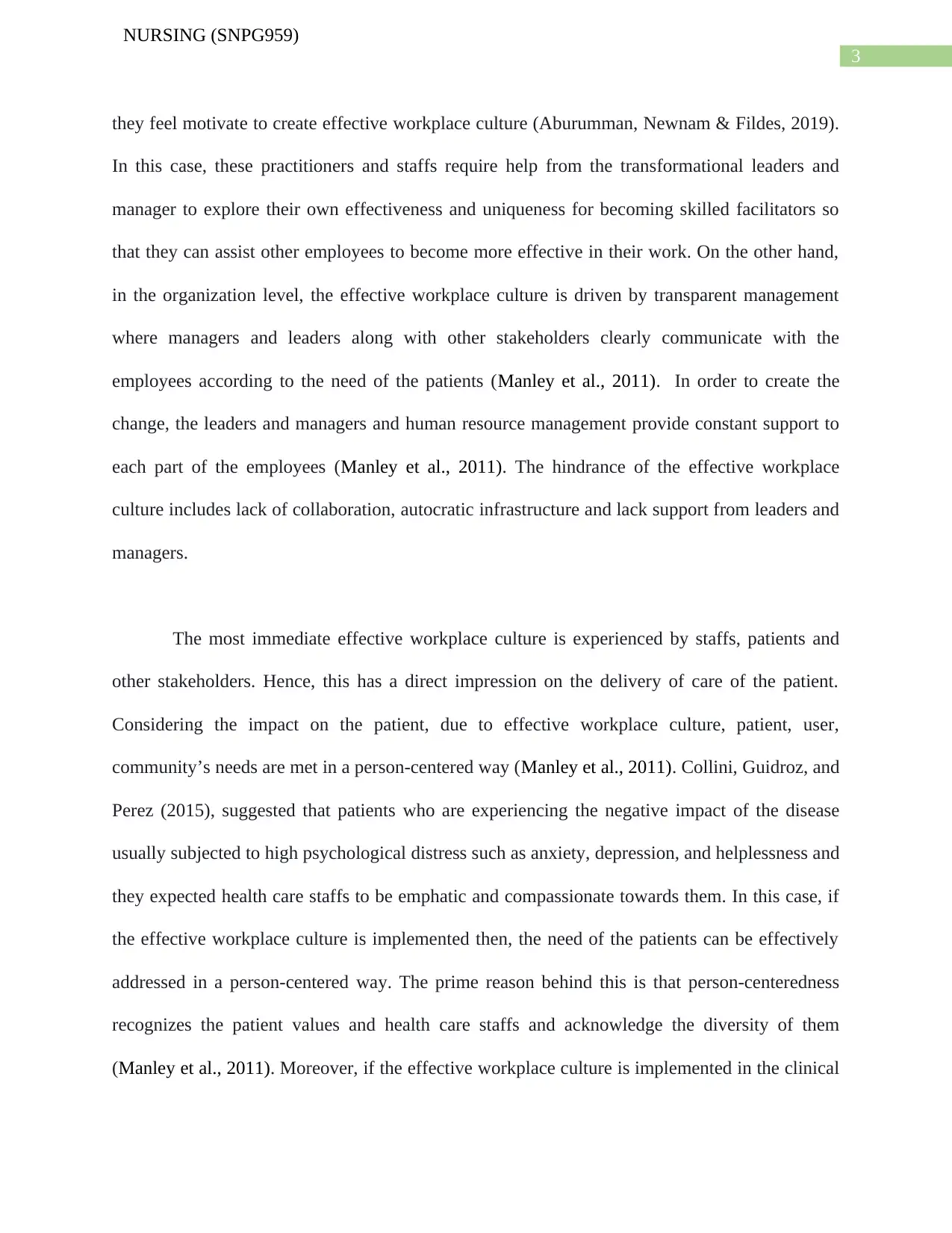
3
NURSING (SNPG959)
they feel motivate to create effective workplace culture (Aburumman, Newnam & Fildes, 2019).
In this case, these practitioners and staffs require help from the transformational leaders and
manager to explore their own effectiveness and uniqueness for becoming skilled facilitators so
that they can assist other employees to become more effective in their work. On the other hand,
in the organization level, the effective workplace culture is driven by transparent management
where managers and leaders along with other stakeholders clearly communicate with the
employees according to the need of the patients (Manley et al., 2011). In order to create the
change, the leaders and managers and human resource management provide constant support to
each part of the employees (Manley et al., 2011). The hindrance of the effective workplace
culture includes lack of collaboration, autocratic infrastructure and lack support from leaders and
managers.
The most immediate effective workplace culture is experienced by staffs, patients and
other stakeholders. Hence, this has a direct impression on the delivery of care of the patient.
Considering the impact on the patient, due to effective workplace culture, patient, user,
community’s needs are met in a person-centered way (Manley et al., 2011). Collini, Guidroz, and
Perez (2015), suggested that patients who are experiencing the negative impact of the disease
usually subjected to high psychological distress such as anxiety, depression, and helplessness and
they expected health care staffs to be emphatic and compassionate towards them. In this case, if
the effective workplace culture is implemented then, the need of the patients can be effectively
addressed in a person-centered way. The prime reason behind this is that person-centeredness
recognizes the patient values and health care staffs and acknowledge the diversity of them
(Manley et al., 2011). Moreover, if the effective workplace culture is implemented in the clinical
NURSING (SNPG959)
they feel motivate to create effective workplace culture (Aburumman, Newnam & Fildes, 2019).
In this case, these practitioners and staffs require help from the transformational leaders and
manager to explore their own effectiveness and uniqueness for becoming skilled facilitators so
that they can assist other employees to become more effective in their work. On the other hand,
in the organization level, the effective workplace culture is driven by transparent management
where managers and leaders along with other stakeholders clearly communicate with the
employees according to the need of the patients (Manley et al., 2011). In order to create the
change, the leaders and managers and human resource management provide constant support to
each part of the employees (Manley et al., 2011). The hindrance of the effective workplace
culture includes lack of collaboration, autocratic infrastructure and lack support from leaders and
managers.
The most immediate effective workplace culture is experienced by staffs, patients and
other stakeholders. Hence, this has a direct impression on the delivery of care of the patient.
Considering the impact on the patient, due to effective workplace culture, patient, user,
community’s needs are met in a person-centered way (Manley et al., 2011). Collini, Guidroz, and
Perez (2015), suggested that patients who are experiencing the negative impact of the disease
usually subjected to high psychological distress such as anxiety, depression, and helplessness and
they expected health care staffs to be emphatic and compassionate towards them. In this case, if
the effective workplace culture is implemented then, the need of the patients can be effectively
addressed in a person-centered way. The prime reason behind this is that person-centeredness
recognizes the patient values and health care staffs and acknowledge the diversity of them
(Manley et al., 2011). Moreover, if the effective workplace culture is implemented in the clinical
Paraphrase This Document
Need a fresh take? Get an instant paraphrase of this document with our AI Paraphraser
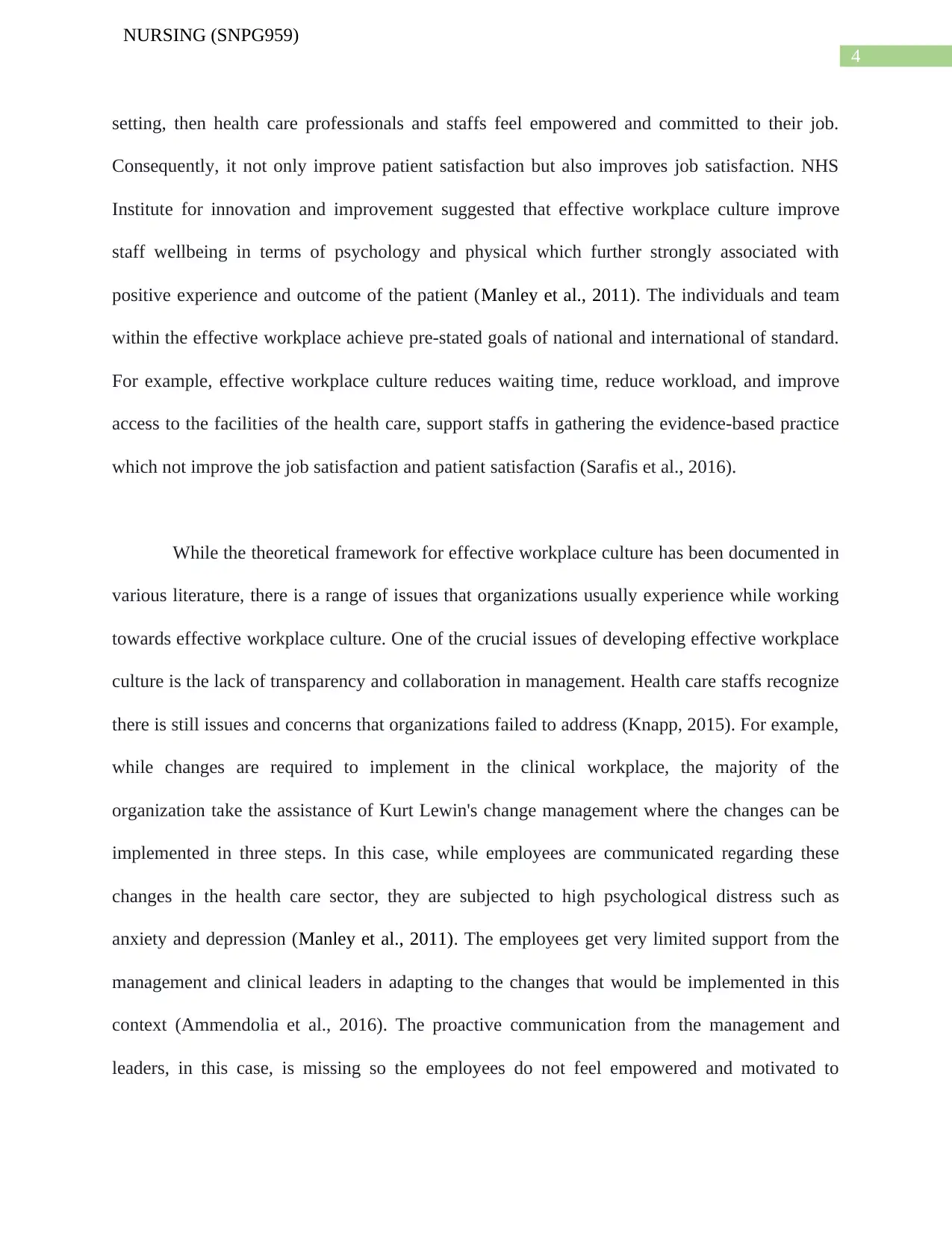
4
NURSING (SNPG959)
setting, then health care professionals and staffs feel empowered and committed to their job.
Consequently, it not only improve patient satisfaction but also improves job satisfaction. NHS
Institute for innovation and improvement suggested that effective workplace culture improve
staff wellbeing in terms of psychology and physical which further strongly associated with
positive experience and outcome of the patient (Manley et al., 2011). The individuals and team
within the effective workplace achieve pre-stated goals of national and international of standard.
For example, effective workplace culture reduces waiting time, reduce workload, and improve
access to the facilities of the health care, support staffs in gathering the evidence-based practice
which not improve the job satisfaction and patient satisfaction (Sarafis et al., 2016).
While the theoretical framework for effective workplace culture has been documented in
various literature, there is a range of issues that organizations usually experience while working
towards effective workplace culture. One of the crucial issues of developing effective workplace
culture is the lack of transparency and collaboration in management. Health care staffs recognize
there is still issues and concerns that organizations failed to address (Knapp, 2015). For example,
while changes are required to implement in the clinical workplace, the majority of the
organization take the assistance of Kurt Lewin's change management where the changes can be
implemented in three steps. In this case, while employees are communicated regarding these
changes in the health care sector, they are subjected to high psychological distress such as
anxiety and depression (Manley et al., 2011). The employees get very limited support from the
management and clinical leaders in adapting to the changes that would be implemented in this
context (Ammendolia et al., 2016). The proactive communication from the management and
leaders, in this case, is missing so the employees do not feel empowered and motivated to
NURSING (SNPG959)
setting, then health care professionals and staffs feel empowered and committed to their job.
Consequently, it not only improve patient satisfaction but also improves job satisfaction. NHS
Institute for innovation and improvement suggested that effective workplace culture improve
staff wellbeing in terms of psychology and physical which further strongly associated with
positive experience and outcome of the patient (Manley et al., 2011). The individuals and team
within the effective workplace achieve pre-stated goals of national and international of standard.
For example, effective workplace culture reduces waiting time, reduce workload, and improve
access to the facilities of the health care, support staffs in gathering the evidence-based practice
which not improve the job satisfaction and patient satisfaction (Sarafis et al., 2016).
While the theoretical framework for effective workplace culture has been documented in
various literature, there is a range of issues that organizations usually experience while working
towards effective workplace culture. One of the crucial issues of developing effective workplace
culture is the lack of transparency and collaboration in management. Health care staffs recognize
there is still issues and concerns that organizations failed to address (Knapp, 2015). For example,
while changes are required to implement in the clinical workplace, the majority of the
organization take the assistance of Kurt Lewin's change management where the changes can be
implemented in three steps. In this case, while employees are communicated regarding these
changes in the health care sector, they are subjected to high psychological distress such as
anxiety and depression (Manley et al., 2011). The employees get very limited support from the
management and clinical leaders in adapting to the changes that would be implemented in this
context (Ammendolia et al., 2016). The proactive communication from the management and
leaders, in this case, is missing so the employees do not feel empowered and motivated to
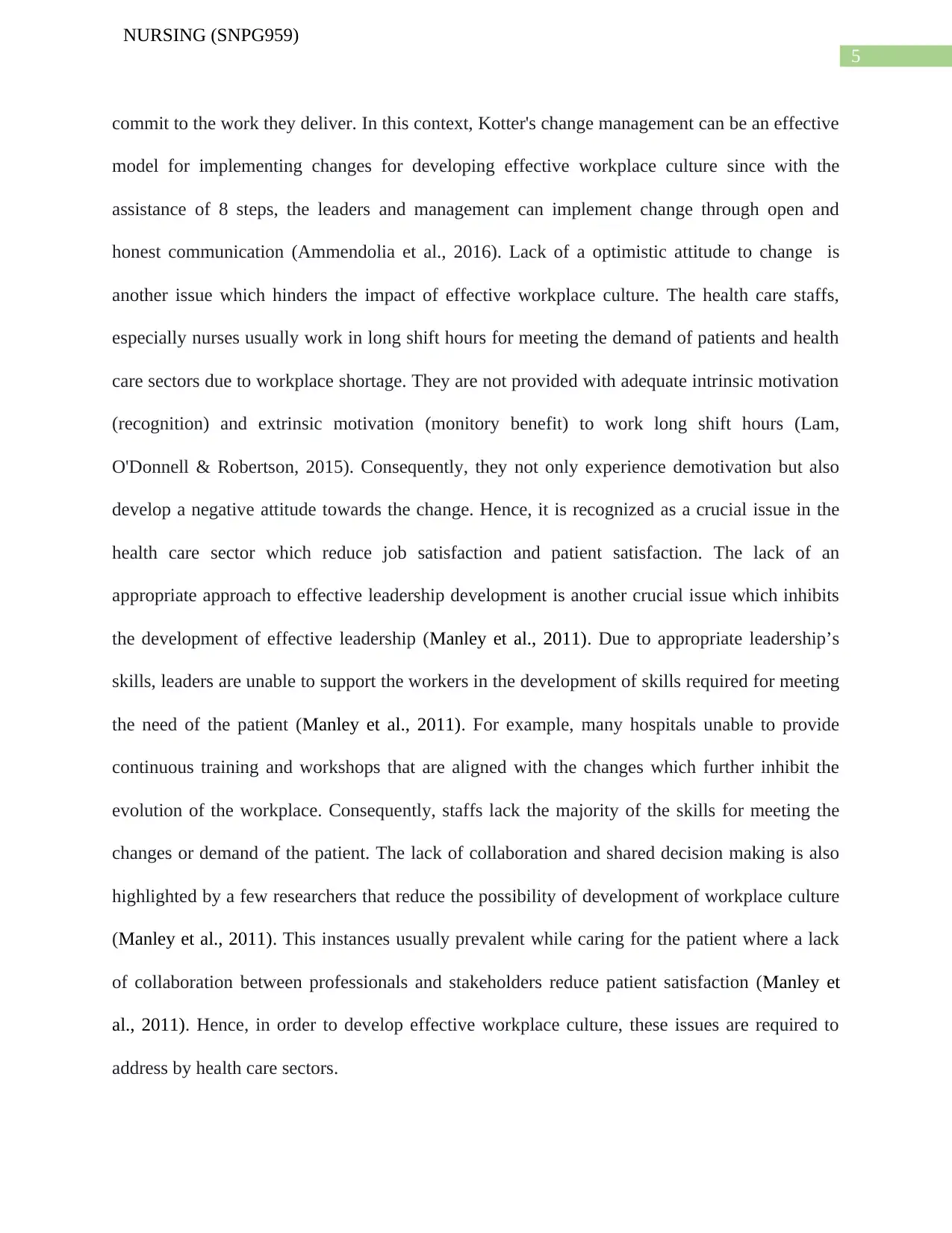
5
NURSING (SNPG959)
commit to the work they deliver. In this context, Kotter's change management can be an effective
model for implementing changes for developing effective workplace culture since with the
assistance of 8 steps, the leaders and management can implement change through open and
honest communication (Ammendolia et al., 2016). Lack of a optimistic attitude to change is
another issue which hinders the impact of effective workplace culture. The health care staffs,
especially nurses usually work in long shift hours for meeting the demand of patients and health
care sectors due to workplace shortage. They are not provided with adequate intrinsic motivation
(recognition) and extrinsic motivation (monitory benefit) to work long shift hours (Lam,
O'Donnell & Robertson, 2015). Consequently, they not only experience demotivation but also
develop a negative attitude towards the change. Hence, it is recognized as a crucial issue in the
health care sector which reduce job satisfaction and patient satisfaction. The lack of an
appropriate approach to effective leadership development is another crucial issue which inhibits
the development of effective leadership (Manley et al., 2011). Due to appropriate leadership’s
skills, leaders are unable to support the workers in the development of skills required for meeting
the need of the patient (Manley et al., 2011). For example, many hospitals unable to provide
continuous training and workshops that are aligned with the changes which further inhibit the
evolution of the workplace. Consequently, staffs lack the majority of the skills for meeting the
changes or demand of the patient. The lack of collaboration and shared decision making is also
highlighted by a few researchers that reduce the possibility of development of workplace culture
(Manley et al., 2011). This instances usually prevalent while caring for the patient where a lack
of collaboration between professionals and stakeholders reduce patient satisfaction (Manley et
al., 2011). Hence, in order to develop effective workplace culture, these issues are required to
address by health care sectors.
NURSING (SNPG959)
commit to the work they deliver. In this context, Kotter's change management can be an effective
model for implementing changes for developing effective workplace culture since with the
assistance of 8 steps, the leaders and management can implement change through open and
honest communication (Ammendolia et al., 2016). Lack of a optimistic attitude to change is
another issue which hinders the impact of effective workplace culture. The health care staffs,
especially nurses usually work in long shift hours for meeting the demand of patients and health
care sectors due to workplace shortage. They are not provided with adequate intrinsic motivation
(recognition) and extrinsic motivation (monitory benefit) to work long shift hours (Lam,
O'Donnell & Robertson, 2015). Consequently, they not only experience demotivation but also
develop a negative attitude towards the change. Hence, it is recognized as a crucial issue in the
health care sector which reduce job satisfaction and patient satisfaction. The lack of an
appropriate approach to effective leadership development is another crucial issue which inhibits
the development of effective leadership (Manley et al., 2011). Due to appropriate leadership’s
skills, leaders are unable to support the workers in the development of skills required for meeting
the need of the patient (Manley et al., 2011). For example, many hospitals unable to provide
continuous training and workshops that are aligned with the changes which further inhibit the
evolution of the workplace. Consequently, staffs lack the majority of the skills for meeting the
changes or demand of the patient. The lack of collaboration and shared decision making is also
highlighted by a few researchers that reduce the possibility of development of workplace culture
(Manley et al., 2011). This instances usually prevalent while caring for the patient where a lack
of collaboration between professionals and stakeholders reduce patient satisfaction (Manley et
al., 2011). Hence, in order to develop effective workplace culture, these issues are required to
address by health care sectors.
⊘ This is a preview!⊘
Do you want full access?
Subscribe today to unlock all pages.

Trusted by 1+ million students worldwide
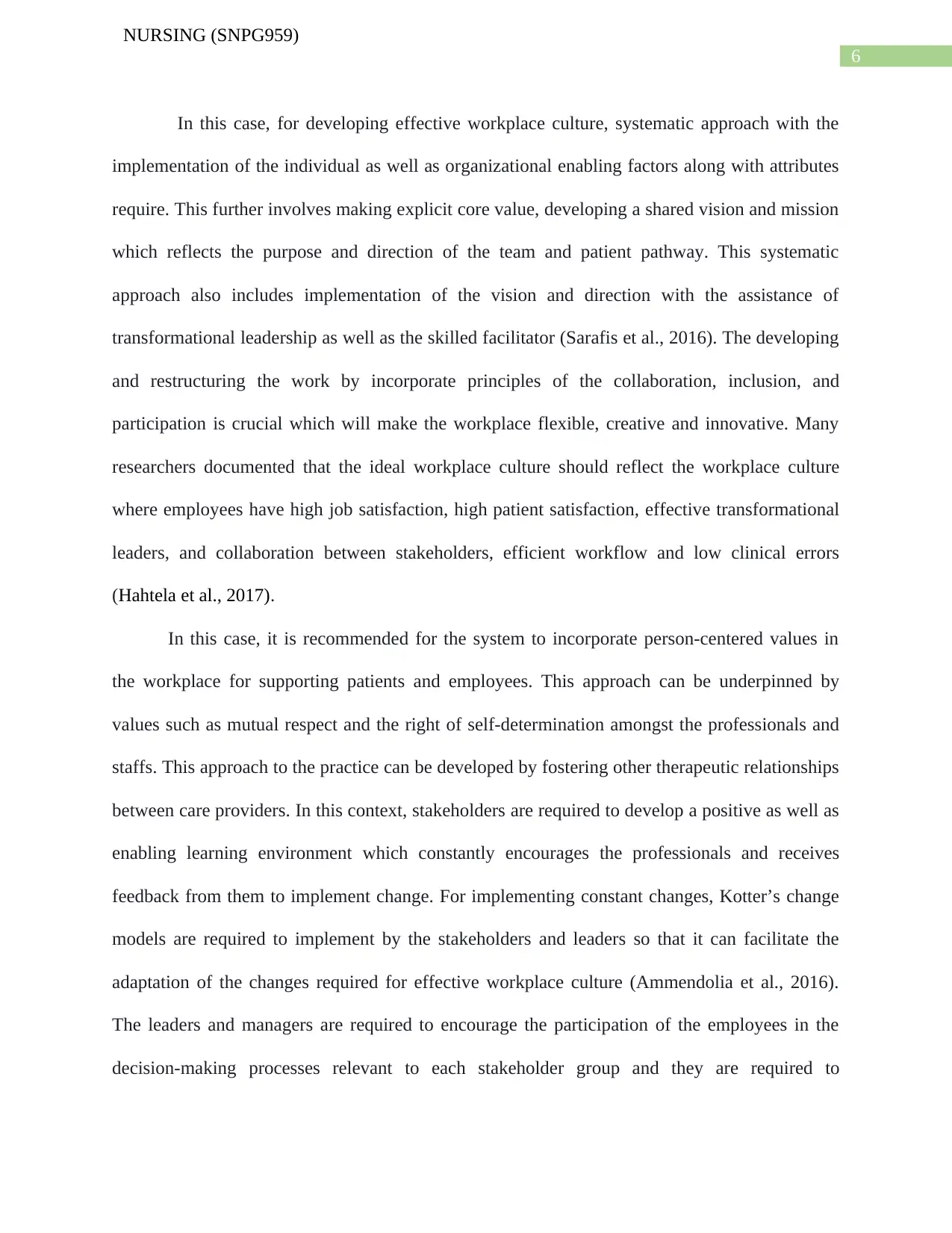
6
NURSING (SNPG959)
In this case, for developing effective workplace culture, systematic approach with the
implementation of the individual as well as organizational enabling factors along with attributes
require. This further involves making explicit core value, developing a shared vision and mission
which reflects the purpose and direction of the team and patient pathway. This systematic
approach also includes implementation of the vision and direction with the assistance of
transformational leadership as well as the skilled facilitator (Sarafis et al., 2016). The developing
and restructuring the work by incorporate principles of the collaboration, inclusion, and
participation is crucial which will make the workplace flexible, creative and innovative. Many
researchers documented that the ideal workplace culture should reflect the workplace culture
where employees have high job satisfaction, high patient satisfaction, effective transformational
leaders, and collaboration between stakeholders, efficient workflow and low clinical errors
(Hahtela et al., 2017).
In this case, it is recommended for the system to incorporate person-centered values in
the workplace for supporting patients and employees. This approach can be underpinned by
values such as mutual respect and the right of self-determination amongst the professionals and
staffs. This approach to the practice can be developed by fostering other therapeutic relationships
between care providers. In this context, stakeholders are required to develop a positive as well as
enabling learning environment which constantly encourages the professionals and receives
feedback from them to implement change. For implementing constant changes, Kotter’s change
models are required to implement by the stakeholders and leaders so that it can facilitate the
adaptation of the changes required for effective workplace culture (Ammendolia et al., 2016).
The leaders and managers are required to encourage the participation of the employees in the
decision-making processes relevant to each stakeholder group and they are required to
NURSING (SNPG959)
In this case, for developing effective workplace culture, systematic approach with the
implementation of the individual as well as organizational enabling factors along with attributes
require. This further involves making explicit core value, developing a shared vision and mission
which reflects the purpose and direction of the team and patient pathway. This systematic
approach also includes implementation of the vision and direction with the assistance of
transformational leadership as well as the skilled facilitator (Sarafis et al., 2016). The developing
and restructuring the work by incorporate principles of the collaboration, inclusion, and
participation is crucial which will make the workplace flexible, creative and innovative. Many
researchers documented that the ideal workplace culture should reflect the workplace culture
where employees have high job satisfaction, high patient satisfaction, effective transformational
leaders, and collaboration between stakeholders, efficient workflow and low clinical errors
(Hahtela et al., 2017).
In this case, it is recommended for the system to incorporate person-centered values in
the workplace for supporting patients and employees. This approach can be underpinned by
values such as mutual respect and the right of self-determination amongst the professionals and
staffs. This approach to the practice can be developed by fostering other therapeutic relationships
between care providers. In this context, stakeholders are required to develop a positive as well as
enabling learning environment which constantly encourages the professionals and receives
feedback from them to implement change. For implementing constant changes, Kotter’s change
models are required to implement by the stakeholders and leaders so that it can facilitate the
adaptation of the changes required for effective workplace culture (Ammendolia et al., 2016).
The leaders and managers are required to encourage the participation of the employees in the
decision-making processes relevant to each stakeholder group and they are required to
Paraphrase This Document
Need a fresh take? Get an instant paraphrase of this document with our AI Paraphraser
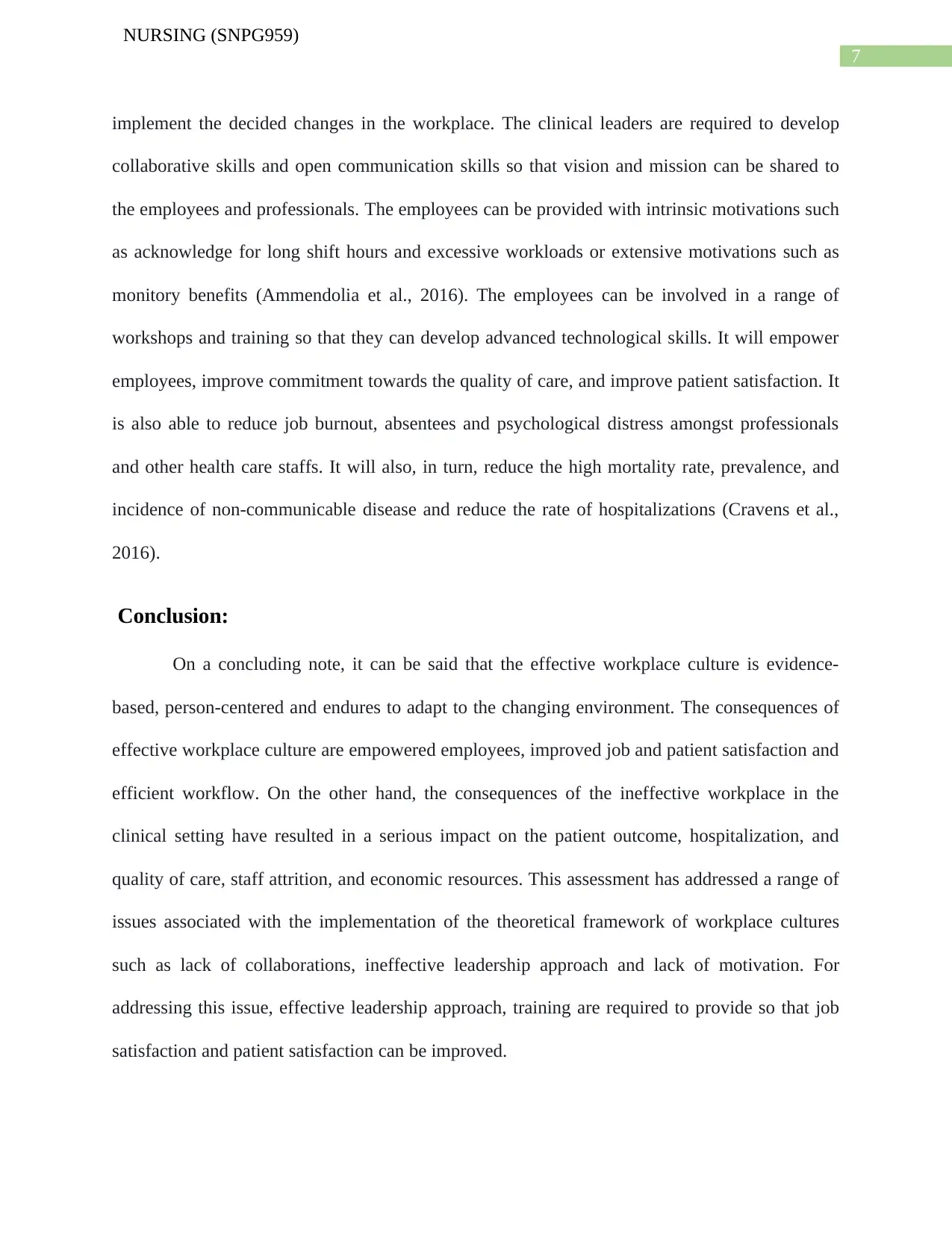
7
NURSING (SNPG959)
implement the decided changes in the workplace. The clinical leaders are required to develop
collaborative skills and open communication skills so that vision and mission can be shared to
the employees and professionals. The employees can be provided with intrinsic motivations such
as acknowledge for long shift hours and excessive workloads or extensive motivations such as
monitory benefits (Ammendolia et al., 2016). The employees can be involved in a range of
workshops and training so that they can develop advanced technological skills. It will empower
employees, improve commitment towards the quality of care, and improve patient satisfaction. It
is also able to reduce job burnout, absentees and psychological distress amongst professionals
and other health care staffs. It will also, in turn, reduce the high mortality rate, prevalence, and
incidence of non-communicable disease and reduce the rate of hospitalizations (Cravens et al.,
2016).
Conclusion:
On a concluding note, it can be said that the effective workplace culture is evidence-
based, person-centered and endures to adapt to the changing environment. The consequences of
effective workplace culture are empowered employees, improved job and patient satisfaction and
efficient workflow. On the other hand, the consequences of the ineffective workplace in the
clinical setting have resulted in a serious impact on the patient outcome, hospitalization, and
quality of care, staff attrition, and economic resources. This assessment has addressed a range of
issues associated with the implementation of the theoretical framework of workplace cultures
such as lack of collaborations, ineffective leadership approach and lack of motivation. For
addressing this issue, effective leadership approach, training are required to provide so that job
satisfaction and patient satisfaction can be improved.
NURSING (SNPG959)
implement the decided changes in the workplace. The clinical leaders are required to develop
collaborative skills and open communication skills so that vision and mission can be shared to
the employees and professionals. The employees can be provided with intrinsic motivations such
as acknowledge for long shift hours and excessive workloads or extensive motivations such as
monitory benefits (Ammendolia et al., 2016). The employees can be involved in a range of
workshops and training so that they can develop advanced technological skills. It will empower
employees, improve commitment towards the quality of care, and improve patient satisfaction. It
is also able to reduce job burnout, absentees and psychological distress amongst professionals
and other health care staffs. It will also, in turn, reduce the high mortality rate, prevalence, and
incidence of non-communicable disease and reduce the rate of hospitalizations (Cravens et al.,
2016).
Conclusion:
On a concluding note, it can be said that the effective workplace culture is evidence-
based, person-centered and endures to adapt to the changing environment. The consequences of
effective workplace culture are empowered employees, improved job and patient satisfaction and
efficient workflow. On the other hand, the consequences of the ineffective workplace in the
clinical setting have resulted in a serious impact on the patient outcome, hospitalization, and
quality of care, staff attrition, and economic resources. This assessment has addressed a range of
issues associated with the implementation of the theoretical framework of workplace cultures
such as lack of collaborations, ineffective leadership approach and lack of motivation. For
addressing this issue, effective leadership approach, training are required to provide so that job
satisfaction and patient satisfaction can be improved.
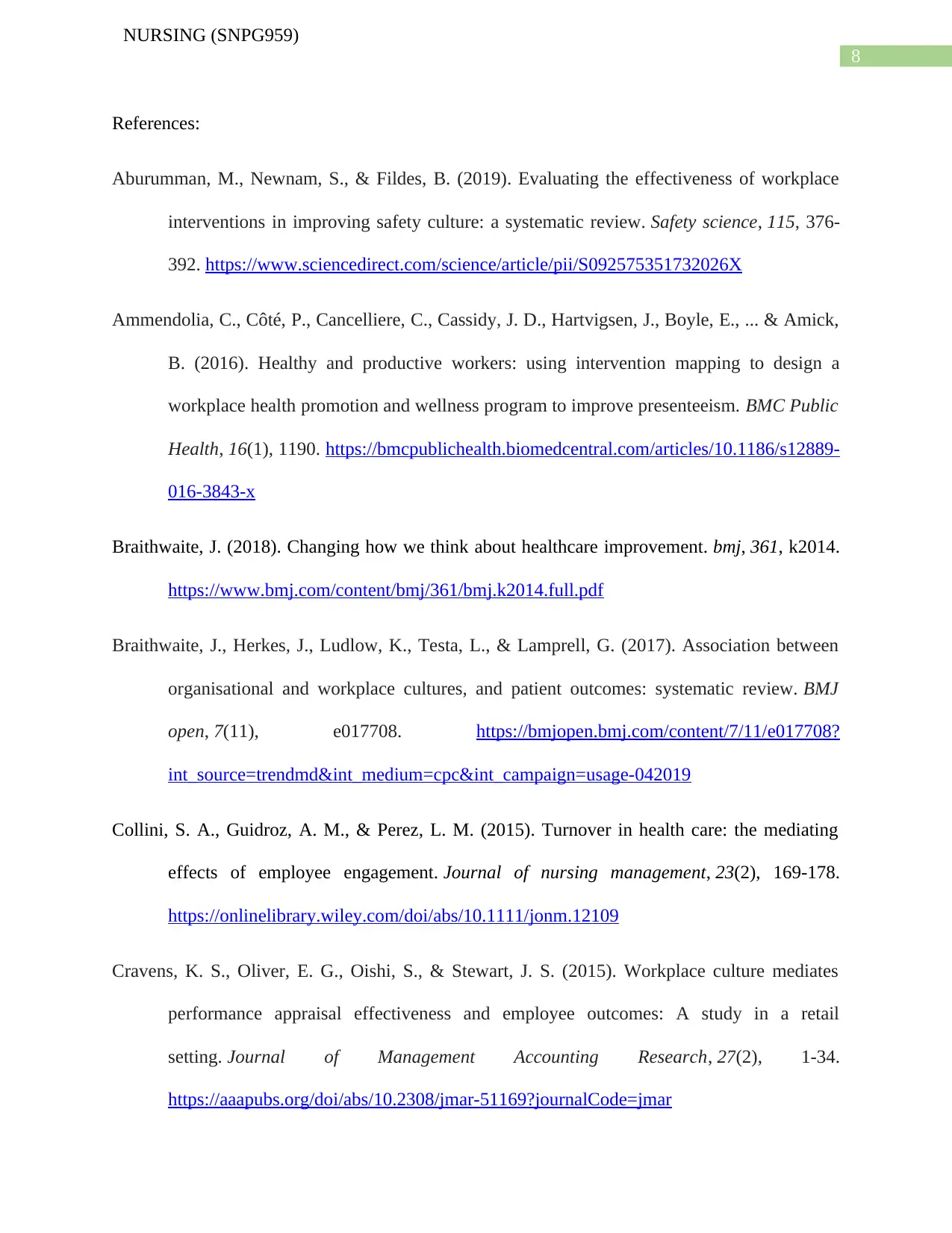
8
NURSING (SNPG959)
References:
Aburumman, M., Newnam, S., & Fildes, B. (2019). Evaluating the effectiveness of workplace
interventions in improving safety culture: a systematic review. Safety science, 115, 376-
392. https://www.sciencedirect.com/science/article/pii/S092575351732026X
Ammendolia, C., Côté, P., Cancelliere, C., Cassidy, J. D., Hartvigsen, J., Boyle, E., ... & Amick,
B. (2016). Healthy and productive workers: using intervention mapping to design a
workplace health promotion and wellness program to improve presenteeism. BMC Public
Health, 16(1), 1190. https://bmcpublichealth.biomedcentral.com/articles/10.1186/s12889-
016-3843-x
Braithwaite, J. (2018). Changing how we think about healthcare improvement. bmj, 361, k2014.
https://www.bmj.com/content/bmj/361/bmj.k2014.full.pdf
Braithwaite, J., Herkes, J., Ludlow, K., Testa, L., & Lamprell, G. (2017). Association between
organisational and workplace cultures, and patient outcomes: systematic review. BMJ
open, 7(11), e017708. https://bmjopen.bmj.com/content/7/11/e017708?
int_source=trendmd&int_medium=cpc&int_campaign=usage-042019
Collini, S. A., Guidroz, A. M., & Perez, L. M. (2015). Turnover in health care: the mediating
effects of employee engagement. Journal of nursing management, 23(2), 169-178.
https://onlinelibrary.wiley.com/doi/abs/10.1111/jonm.12109
Cravens, K. S., Oliver, E. G., Oishi, S., & Stewart, J. S. (2015). Workplace culture mediates
performance appraisal effectiveness and employee outcomes: A study in a retail
setting. Journal of Management Accounting Research, 27(2), 1-34.
https://aaapubs.org/doi/abs/10.2308/jmar-51169?journalCode=jmar
NURSING (SNPG959)
References:
Aburumman, M., Newnam, S., & Fildes, B. (2019). Evaluating the effectiveness of workplace
interventions in improving safety culture: a systematic review. Safety science, 115, 376-
392. https://www.sciencedirect.com/science/article/pii/S092575351732026X
Ammendolia, C., Côté, P., Cancelliere, C., Cassidy, J. D., Hartvigsen, J., Boyle, E., ... & Amick,
B. (2016). Healthy and productive workers: using intervention mapping to design a
workplace health promotion and wellness program to improve presenteeism. BMC Public
Health, 16(1), 1190. https://bmcpublichealth.biomedcentral.com/articles/10.1186/s12889-
016-3843-x
Braithwaite, J. (2018). Changing how we think about healthcare improvement. bmj, 361, k2014.
https://www.bmj.com/content/bmj/361/bmj.k2014.full.pdf
Braithwaite, J., Herkes, J., Ludlow, K., Testa, L., & Lamprell, G. (2017). Association between
organisational and workplace cultures, and patient outcomes: systematic review. BMJ
open, 7(11), e017708. https://bmjopen.bmj.com/content/7/11/e017708?
int_source=trendmd&int_medium=cpc&int_campaign=usage-042019
Collini, S. A., Guidroz, A. M., & Perez, L. M. (2015). Turnover in health care: the mediating
effects of employee engagement. Journal of nursing management, 23(2), 169-178.
https://onlinelibrary.wiley.com/doi/abs/10.1111/jonm.12109
Cravens, K. S., Oliver, E. G., Oishi, S., & Stewart, J. S. (2015). Workplace culture mediates
performance appraisal effectiveness and employee outcomes: A study in a retail
setting. Journal of Management Accounting Research, 27(2), 1-34.
https://aaapubs.org/doi/abs/10.2308/jmar-51169?journalCode=jmar
⊘ This is a preview!⊘
Do you want full access?
Subscribe today to unlock all pages.

Trusted by 1+ million students worldwide
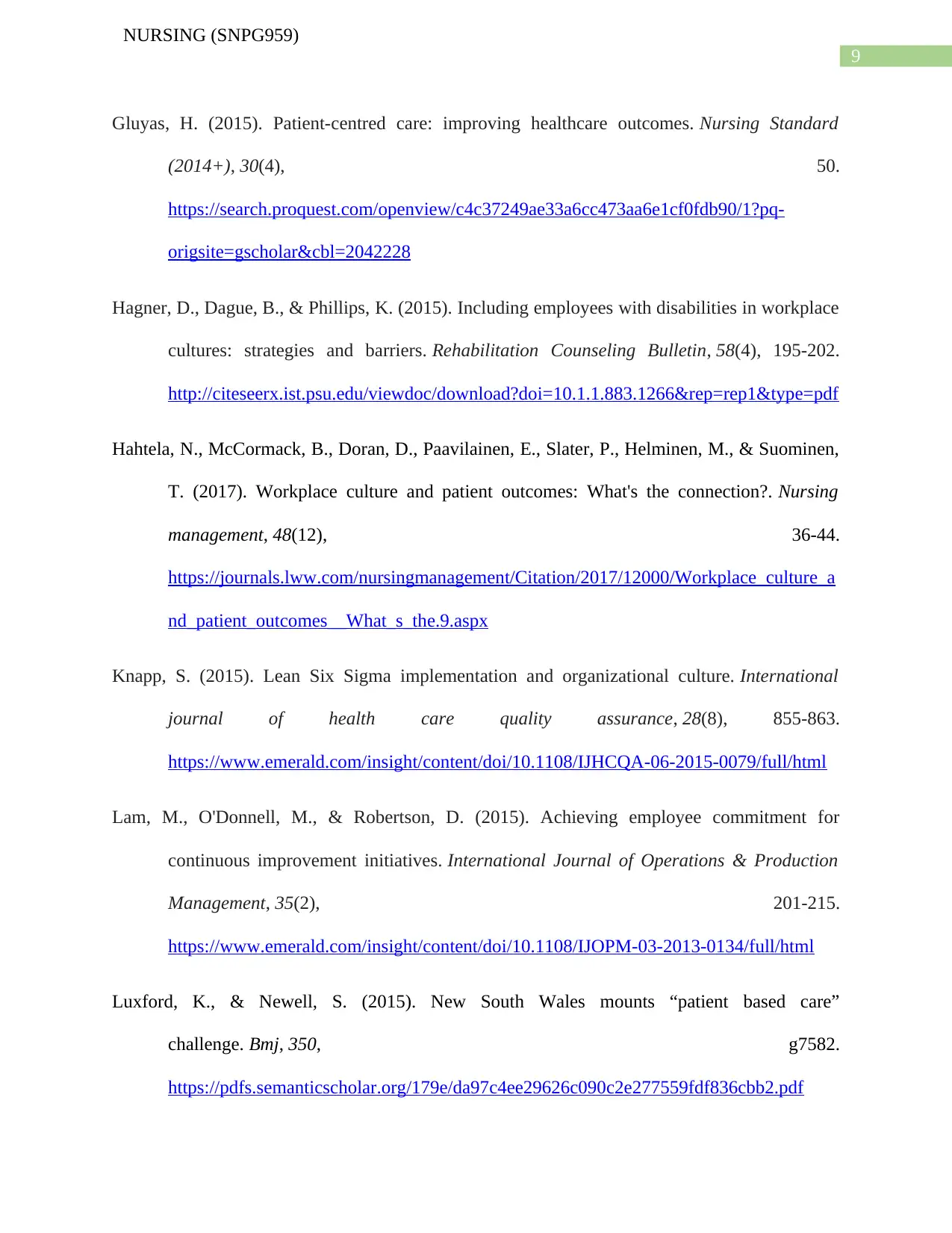
9
NURSING (SNPG959)
Gluyas, H. (2015). Patient-centred care: improving healthcare outcomes. Nursing Standard
(2014+), 30(4), 50.
https://search.proquest.com/openview/c4c37249ae33a6cc473aa6e1cf0fdb90/1?pq-
origsite=gscholar&cbl=2042228
Hagner, D., Dague, B., & Phillips, K. (2015). Including employees with disabilities in workplace
cultures: strategies and barriers. Rehabilitation Counseling Bulletin, 58(4), 195-202.
http://citeseerx.ist.psu.edu/viewdoc/download?doi=10.1.1.883.1266&rep=rep1&type=pdf
Hahtela, N., McCormack, B., Doran, D., Paavilainen, E., Slater, P., Helminen, M., & Suominen,
T. (2017). Workplace culture and patient outcomes: What's the connection?. Nursing
management, 48(12), 36-44.
https://journals.lww.com/nursingmanagement/Citation/2017/12000/Workplace_culture_a
nd_patient_outcomes__What_s_the.9.aspx
Knapp, S. (2015). Lean Six Sigma implementation and organizational culture. International
journal of health care quality assurance, 28(8), 855-863.
https://www.emerald.com/insight/content/doi/10.1108/IJHCQA-06-2015-0079/full/html
Lam, M., O'Donnell, M., & Robertson, D. (2015). Achieving employee commitment for
continuous improvement initiatives. International Journal of Operations & Production
Management, 35(2), 201-215.
https://www.emerald.com/insight/content/doi/10.1108/IJOPM-03-2013-0134/full/html
Luxford, K., & Newell, S. (2015). New South Wales mounts “patient based care”
challenge. Bmj, 350, g7582.
https://pdfs.semanticscholar.org/179e/da97c4ee29626c090c2e277559fdf836cbb2.pdf
NURSING (SNPG959)
Gluyas, H. (2015). Patient-centred care: improving healthcare outcomes. Nursing Standard
(2014+), 30(4), 50.
https://search.proquest.com/openview/c4c37249ae33a6cc473aa6e1cf0fdb90/1?pq-
origsite=gscholar&cbl=2042228
Hagner, D., Dague, B., & Phillips, K. (2015). Including employees with disabilities in workplace
cultures: strategies and barriers. Rehabilitation Counseling Bulletin, 58(4), 195-202.
http://citeseerx.ist.psu.edu/viewdoc/download?doi=10.1.1.883.1266&rep=rep1&type=pdf
Hahtela, N., McCormack, B., Doran, D., Paavilainen, E., Slater, P., Helminen, M., & Suominen,
T. (2017). Workplace culture and patient outcomes: What's the connection?. Nursing
management, 48(12), 36-44.
https://journals.lww.com/nursingmanagement/Citation/2017/12000/Workplace_culture_a
nd_patient_outcomes__What_s_the.9.aspx
Knapp, S. (2015). Lean Six Sigma implementation and organizational culture. International
journal of health care quality assurance, 28(8), 855-863.
https://www.emerald.com/insight/content/doi/10.1108/IJHCQA-06-2015-0079/full/html
Lam, M., O'Donnell, M., & Robertson, D. (2015). Achieving employee commitment for
continuous improvement initiatives. International Journal of Operations & Production
Management, 35(2), 201-215.
https://www.emerald.com/insight/content/doi/10.1108/IJOPM-03-2013-0134/full/html
Luxford, K., & Newell, S. (2015). New South Wales mounts “patient based care”
challenge. Bmj, 350, g7582.
https://pdfs.semanticscholar.org/179e/da97c4ee29626c090c2e277559fdf836cbb2.pdf
Paraphrase This Document
Need a fresh take? Get an instant paraphrase of this document with our AI Paraphraser
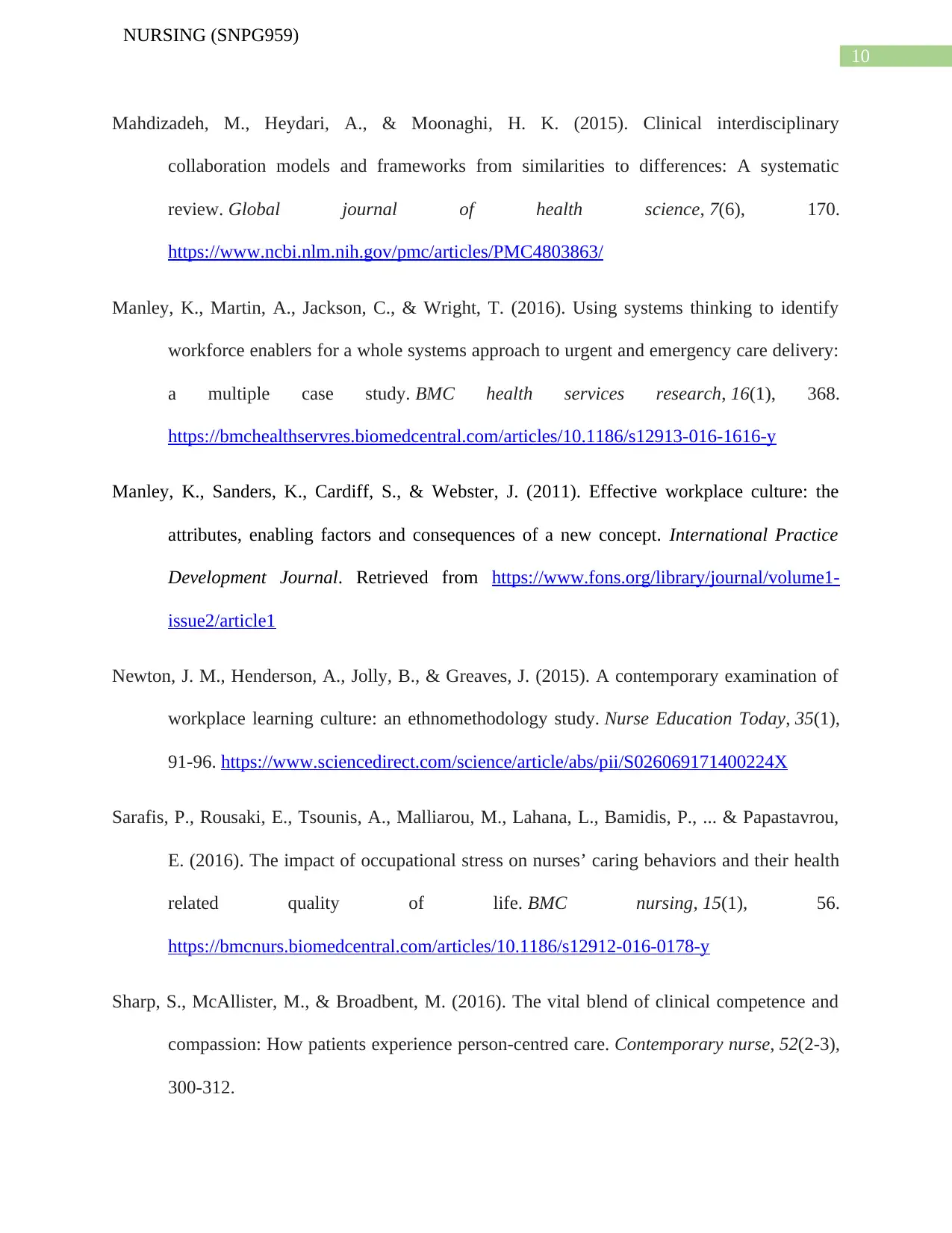
10
NURSING (SNPG959)
Mahdizadeh, M., Heydari, A., & Moonaghi, H. K. (2015). Clinical interdisciplinary
collaboration models and frameworks from similarities to differences: A systematic
review. Global journal of health science, 7(6), 170.
https://www.ncbi.nlm.nih.gov/pmc/articles/PMC4803863/
Manley, K., Martin, A., Jackson, C., & Wright, T. (2016). Using systems thinking to identify
workforce enablers for a whole systems approach to urgent and emergency care delivery:
a multiple case study. BMC health services research, 16(1), 368.
https://bmchealthservres.biomedcentral.com/articles/10.1186/s12913-016-1616-y
Manley, K., Sanders, K., Cardiff, S., & Webster, J. (2011). Effective workplace culture: the
attributes, enabling factors and consequences of a new concept. International Practice
Development Journal. Retrieved from https://www.fons.org/library/journal/volume1-
issue2/article1
Newton, J. M., Henderson, A., Jolly, B., & Greaves, J. (2015). A contemporary examination of
workplace learning culture: an ethnomethodology study. Nurse Education Today, 35(1),
91-96. https://www.sciencedirect.com/science/article/abs/pii/S026069171400224X
Sarafis, P., Rousaki, E., Tsounis, A., Malliarou, M., Lahana, L., Bamidis, P., ... & Papastavrou,
E. (2016). The impact of occupational stress on nurses’ caring behaviors and their health
related quality of life. BMC nursing, 15(1), 56.
https://bmcnurs.biomedcentral.com/articles/10.1186/s12912-016-0178-y
Sharp, S., McAllister, M., & Broadbent, M. (2016). The vital blend of clinical competence and
compassion: How patients experience person-centred care. Contemporary nurse, 52(2-3),
300-312.
NURSING (SNPG959)
Mahdizadeh, M., Heydari, A., & Moonaghi, H. K. (2015). Clinical interdisciplinary
collaboration models and frameworks from similarities to differences: A systematic
review. Global journal of health science, 7(6), 170.
https://www.ncbi.nlm.nih.gov/pmc/articles/PMC4803863/
Manley, K., Martin, A., Jackson, C., & Wright, T. (2016). Using systems thinking to identify
workforce enablers for a whole systems approach to urgent and emergency care delivery:
a multiple case study. BMC health services research, 16(1), 368.
https://bmchealthservres.biomedcentral.com/articles/10.1186/s12913-016-1616-y
Manley, K., Sanders, K., Cardiff, S., & Webster, J. (2011). Effective workplace culture: the
attributes, enabling factors and consequences of a new concept. International Practice
Development Journal. Retrieved from https://www.fons.org/library/journal/volume1-
issue2/article1
Newton, J. M., Henderson, A., Jolly, B., & Greaves, J. (2015). A contemporary examination of
workplace learning culture: an ethnomethodology study. Nurse Education Today, 35(1),
91-96. https://www.sciencedirect.com/science/article/abs/pii/S026069171400224X
Sarafis, P., Rousaki, E., Tsounis, A., Malliarou, M., Lahana, L., Bamidis, P., ... & Papastavrou,
E. (2016). The impact of occupational stress on nurses’ caring behaviors and their health
related quality of life. BMC nursing, 15(1), 56.
https://bmcnurs.biomedcentral.com/articles/10.1186/s12912-016-0178-y
Sharp, S., McAllister, M., & Broadbent, M. (2016). The vital blend of clinical competence and
compassion: How patients experience person-centred care. Contemporary nurse, 52(2-3),
300-312.
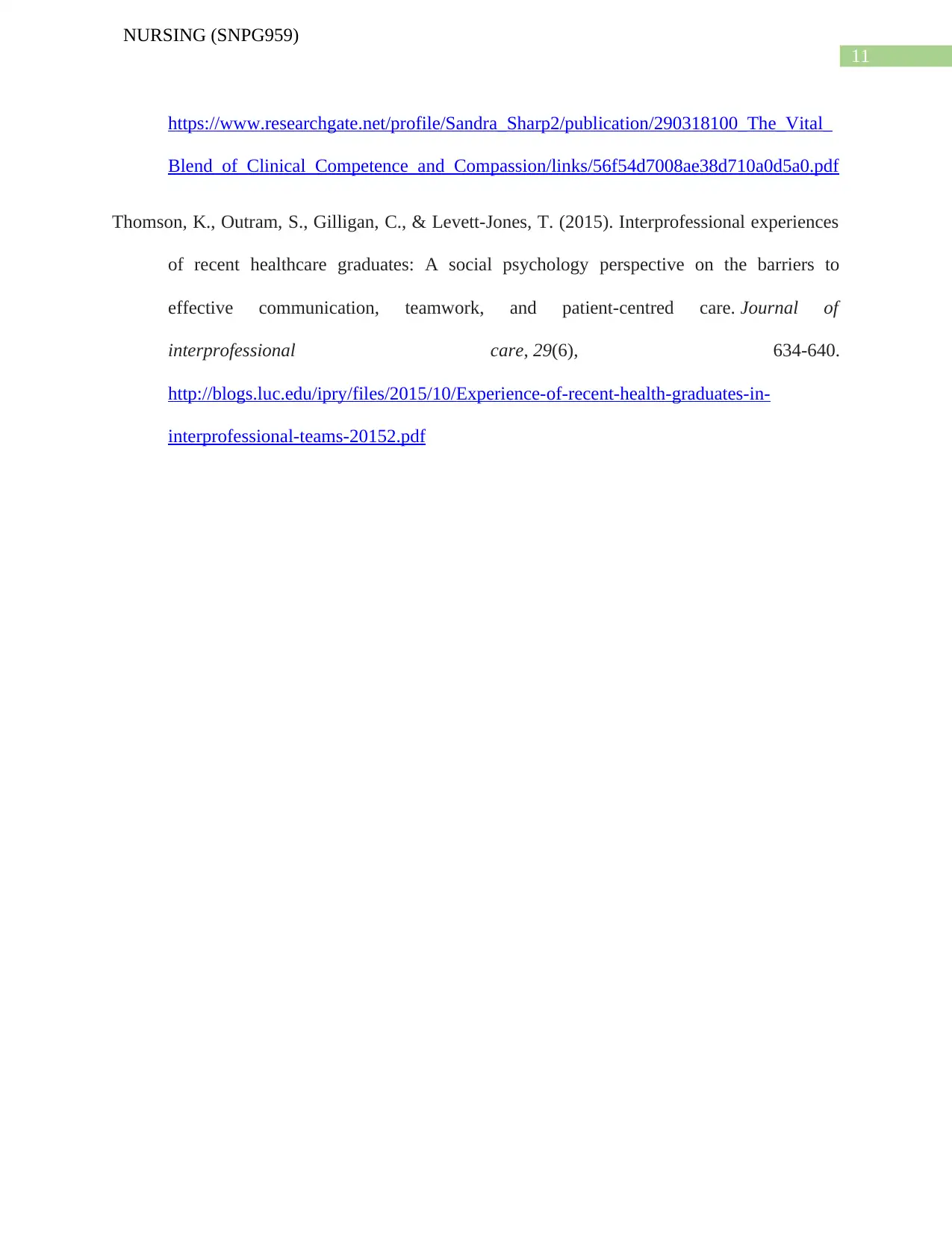
11
NURSING (SNPG959)
https://www.researchgate.net/profile/Sandra_Sharp2/publication/290318100_The_Vital_
Blend_of_Clinical_Competence_and_Compassion/links/56f54d7008ae38d710a0d5a0.pdf
Thomson, K., Outram, S., Gilligan, C., & Levett-Jones, T. (2015). Interprofessional experiences
of recent healthcare graduates: A social psychology perspective on the barriers to
effective communication, teamwork, and patient-centred care. Journal of
interprofessional care, 29(6), 634-640.
http://blogs.luc.edu/ipry/files/2015/10/Experience-of-recent-health-graduates-in-
interprofessional-teams-20152.pdf
NURSING (SNPG959)
https://www.researchgate.net/profile/Sandra_Sharp2/publication/290318100_The_Vital_
Blend_of_Clinical_Competence_and_Compassion/links/56f54d7008ae38d710a0d5a0.pdf
Thomson, K., Outram, S., Gilligan, C., & Levett-Jones, T. (2015). Interprofessional experiences
of recent healthcare graduates: A social psychology perspective on the barriers to
effective communication, teamwork, and patient-centred care. Journal of
interprofessional care, 29(6), 634-640.
http://blogs.luc.edu/ipry/files/2015/10/Experience-of-recent-health-graduates-in-
interprofessional-teams-20152.pdf
⊘ This is a preview!⊘
Do you want full access?
Subscribe today to unlock all pages.

Trusted by 1+ million students worldwide
1 out of 12
Related Documents
Your All-in-One AI-Powered Toolkit for Academic Success.
+13062052269
info@desklib.com
Available 24*7 on WhatsApp / Email
![[object Object]](/_next/static/media/star-bottom.7253800d.svg)
Unlock your academic potential
Copyright © 2020–2025 A2Z Services. All Rights Reserved. Developed and managed by ZUCOL.





